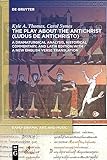The Play about the Antichrist (Ludus de Antichristo) : A Dramaturgical Analysis, Historical Commentary, and Latin Edition with a New English Verse Translation / Carol Symes, Kyle A. Thomas.
Material type: TextSeries: Early Drama, Art, and MusicPublisher: Kalamazoo, MI : Medieval Institute Publications, [2023]Copyright date: ©2023Description: 1 online resource (164 p.)Content type:
TextSeries: Early Drama, Art, and MusicPublisher: Kalamazoo, MI : Medieval Institute Publications, [2023]Copyright date: ©2023Description: 1 online resource (164 p.)Content type: - 9781501517983
- 9781501513572
- 236
- online - DeGruyter
- Issued also in print.
| Item type | Current library | Call number | URL | Status | Notes | Barcode | |
|---|---|---|---|---|---|---|---|
 eBook
eBook
|
Biblioteca "Angelicum" Pont. Univ. S.Tommaso d'Aquino Nuvola online | online - DeGruyter (Browse shelf(Opens below)) | Online access | Not for loan (Accesso limitato) | Accesso per gli utenti autorizzati / Access for authorized users | (dgr)9781501513572 |
Frontmatter -- Contents -- Foreword -- Acknowledgments -- List of Illustrations -- Abbreviations -- Part I: The Play: Historical, Literary, and Performance Contexts (Kyle A. Thomas) -- Introduction -- Chapter 1 A Performance Dramaturgy -- 2 History, Eschatology, and Education: Contextual Frameworks for The Play about the Antichrist -- 3 Liturgies, Æsthetics, and Symbolic Meaning-Making -- Part II: A New Translation and Edition (Kyle A. Thomas, Carol Symes) -- Introduction -- Dramatis Personæ -- Ludus de Antichristo -- The Play about the Antichrist -- Bibliography
restricted access online access with authorization star
http://purl.org/coar/access_right/c_16ec
The Play about the Antichrist (Ludus de Antichristo) was composed around 1160 at the imperial Bavarian abbey of Tegernsee, at a critical point in the power-struggle between the papacy and Emperor Frederick Barbarossa. This new translation and commentary reveals this drama to be strikingly representative of the role that theatrical performance played in shaping contemporary politics, diplomacy, and public opinion. It also shows how drama functioned as an integral component of the educational curricula of elite monastic institutions like Tegernsee, where political administrators and diplomats were trained, and how performance served as a common, connective lingua franca among monasteries in twelfth-century Bavaria. In this new translation, Carol Symes provides the first full and faithful rendering of the play’s dynamic language, maintaining the meter, rhyme scheme, and stage directions of the Latin original and restoring the liturgical elements embedded in the text. Kyle A. Thomas, whose fully-staged production tested the theatricality of this translation, provides a new historical and dramaturgical analysis of the play’s rich interpretive and performative possibilities.
Issued also in print.
Mode of access: Internet via World Wide Web.
In English.
Description based on online resource; title from PDF title page (publisher's Web site, viewed 25. Jun 2024)


